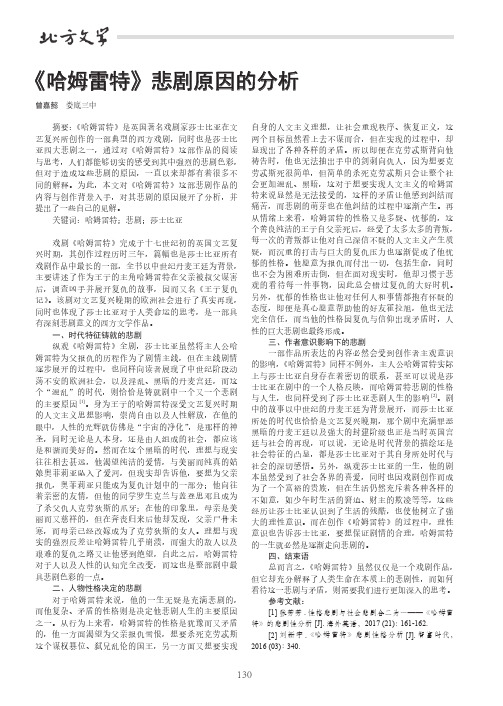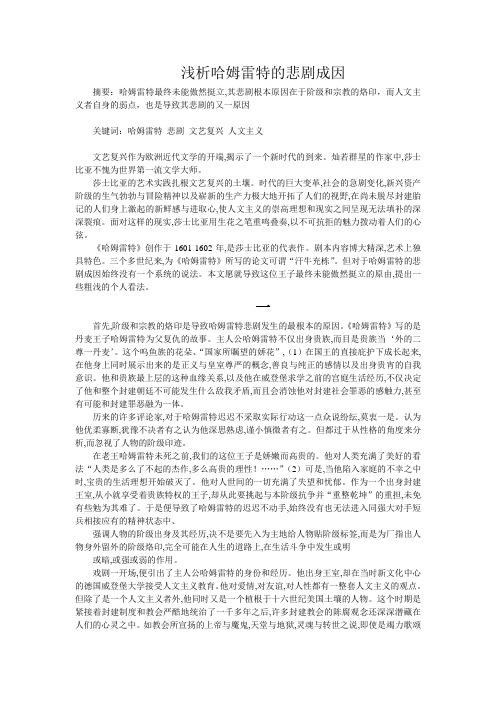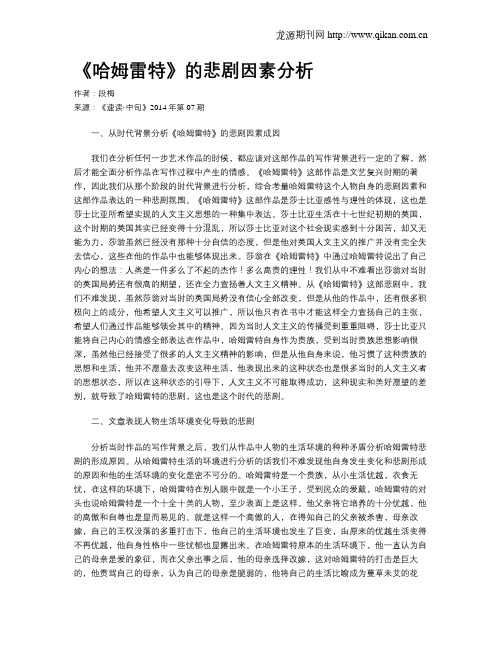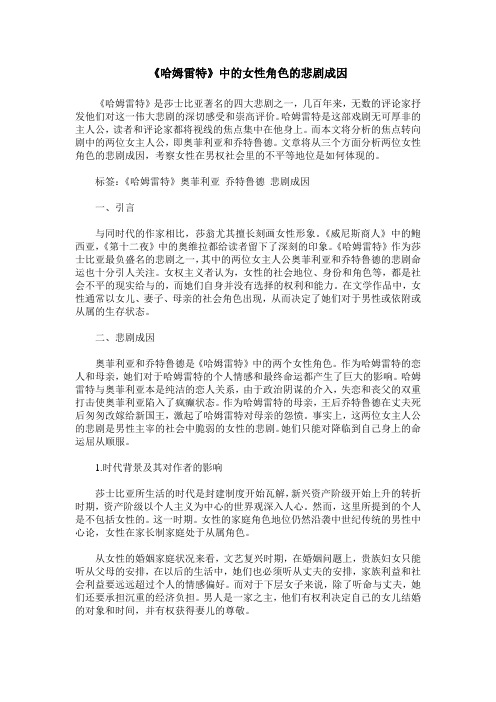《哈姆雷特》戏剧中的悲剧因素(一)讲解
综合作品论述哈姆雷特悲剧实质与原因

综合作品论述哈姆雷特悲剧实质与原因
《哈姆雷特》是莎士比亚最著名的戏剧之一,被普遍认为是世界文学的经典之作。
该剧探讨了复仇、爱情、家族关系以及个人认识和行动的道德困境等多个主题。
《哈姆雷特》的悲剧实质可以从以下几个方面进行论述:
1. 内心冲突与犹豫不决:主人公哈姆雷特面对父亲的死和母亲与叔父的婚姻,内心充满矛盾与痛苦。
他犹豫不决,无法迅速行动,这种矛盾与犹豫最终导致了悲剧的发生。
2. 外在干扰与阴谋:剧中有多个角色在进行复仇与权谋的计划,他们通过欺骗、暗杀等手段,不断向哈姆雷特施加压力。
这些外在干扰也加剧了哈姆雷特的困境。
3. 人性的弱点与缺陷:哈姆雷特身上显现了多个人性的弱点,如犹豫不决、怀疑、嫉妒等。
这些弱点使得他在面对复仇时陷入困境,无法做出明智的选择。
4. 命运与悲剧的注定:无论哈姆雷特的选择如何,似乎都注定了悲剧的发生。
剧中多次提到命运的力量与牵引,这也使得悲剧的产生显得不可避免。
总之,哈姆雷特悲剧的实质与原因是多方面的,既包括个人内心的困惑与犹豫,也包括外在的阴谋与干扰,以及人性的弱点与命运的力量。
这些因素交织在一起,最终导致了悲剧的发生。
《哈姆雷特》中的悲剧原因分析

摘要:《哈姆雷特》是莎士比亚戏剧创作中最杰出的代表作,著名的四大悲剧之一,又是莎士比亚戏剧艺术成熟的标志。
该剧以丰富的时代内涵、生动的人物形象、复杂的矛盾冲突以及曲折多变的故事情节,给人们留下深刻的印象,吸引着他们对其不断的进行解读。
本篇文章旨在从情节、人物、矛盾冲突等多方面分析《哈姆雷特》戏剧中的悲剧色彩。
透过复杂的故事情节,该剧展示了十六世纪英国的动荡与混乱。
该剧中任务众多,不同的任务有不同的性格,也反映了当时不同层次、身份的任务的特征以及他们的人生观。
从而决定了他们最终的归宿。
剧中哈姆雷特与克劳狄斯的斗争是新兴资产阶级人文主义者与日趋反动的封建王权代表任务之间的斗争,反映了文艺复兴时期先进人物为实现美好理想向社会恶势力所进行的斗争。
作为文艺复兴的核心,人文主义在当时是一种新兴思潮,但却遭到失败。
作为人文主义者的典型代表,哈姆雷特对人类抱有美好的看法。
他相信人类的智慧、高雅和力量。
然而,面对罪恶的现实,他所有的人文主义理想都被彻底破灭。
因而只能以生命的代价换来精神上的胜利。
作为时代的缩影,《哈姆雷特》揭示了人文主义理想破灭的必然性。
关键词:人物悲情;矛盾冲突;人文主义;情节悲剧;王权斗争The Tragedy Aspects in HamletAbstract:As one of Shakespeare’s the four famous tragedies, Hamlet is the most remarkable one. It is also the sign of the maturation in the art of Shakespeare’s play. With abundant connotation of the time, vivid characters, complicated conflict and varied story, Hamlet gives people deep impression and moves them to appreciate it. This article aims to analyze the tragedy aspects in Hamlet from all the aspects of plot, character, conflict, and so on, according to which it reveals more information about England in the period of Renaissance. Based on the complicated plots, Hamlet reveals the confusion of England in 16th. In this play, there are many characters. With different character, each one reflects different feature of different stage and their social status, and also their value of life, which decide their final sufferance. The struggle between Hamlet and Claudius is about the conflict between the newly emerged capital humanists and the feudal evil force, which reflects the humanists’ h ardship for their dreams to come true. As the essence of Renaissance, humanism is a newly emerged thought at that time, but unfortunately, it failed. On behalf of humanists, Hamlet confirms human’s value and dignity, and also the wisdom and power, but in front of the evil reality, all his dreams are destroyed completely. He just gets the spiritual victory with the cost of his life. As the mitigation of the time, Hamlet shows that it is destined to fail for humanists.Key Words:Tragedy of Characters; conflict; humanism; tragedy of plots; fighting for throneIntroductionIt is known that Hamlet is the most remarkable works of Shakespeare in his dramas. It describes a story of a prince’s revenge for his father’s death in Denmark, during which, it reveals human-being different conflicts. With abundant connotation of the time, vivid characters, complicated conflict and varied story, Hamlet gives people deep impression and moves them to appreciate it. There are three simultaneous plots of revenge, from which, the tragedy of characters is described more complicated. There is also some description of characters: Hamlet represents the few number of the advanced person emerging in the feudal society; Claudius, who is the head of the reactionary force, is also a schemer, the model character of double-dealer. He is dissolute, insidious and sham. But finally, such unforgivable man bears what he should do; Ophelia, who is one of the loveliest girls Shakespeare has described, is also a tragedy character in this play. She is kind, but because of her innocent and tenderness, she became the tool which her father used topleasant the King.As one of the four famous tragedies, Hamlet is full of tragedy aspects: it described a disordered world, and also a world with strong self-consciousness, which reflected the modern main parts uncertainness and complication in the period of Renaissance. In such a special time, there are all the kinds of formation: Claudius’s schemes to seize the state power; the ethics between the ghost and his s on; the sincere feelings between Hamlet and Ophelia; friendship’s forsaking with old classmates; simultaneous revenge action; the failure of humanism, and so on. With all the formation organized, it forms Hamlet’s special artistic charm and literal achieve ment, which reveal human-being the tragedy aspects of Hamlet incisively and vividly.I. The General Introduction of the StoryIt is a story of a prince’s revenge for his father’s death in Denmark. The King of Denmark died, young prince Hamlet who was making further education abroad came back to his country. Out of his imagination, his mother married his uncle Claudius just after the old King’s death. A ghost who looked like the old King emerged one night, and told Hamlet that it was Claudius who killed him, so Hamlet vowed to revenge. He began to pretend to be mad, and left his lover Ophelia. To spy upon the reflection of Claudius, Hamlet arranged a play which was drawn by him. Claudius realized it, he sent Hamlet to England, and asked the man who kept watch on Hamlet to give letter to the king of England to have Hamlet died. But Claudius failed; Hamlet came back to his country again. Meanwhile Ophelia was drawn because of her father’s death and her lover Hamlet’s drifting apart of her. Her brother Leartes was very angry; he asked to fight with Hamlet. Then Claudius arranged a sword match for them, in which Hamlet was killed by the poison sword, Laertes was wounded to die. The Queen (Hamlet’s mother) died from the poison wine which was prepared for Hamlet by Claudius. Before death, Laertes told the truth. Finally Hamlet killed Claudius with the cost of his life.II. Three Simultaneous Plots of RevengeIn Hamlet, there are three simultaneous plots of revenge, which give more details to help us learn the tragedy aspects in it. There are three characters: Hamlet, Laertes andFortinbius,all of whose father are killed. Based on the concept of the time, all the three persons should revenge for their relatives. As the same task, because of their own character and outlook of life, there are three different ways. Of the three persons, thereare two groups of comparison: Laertes and Hamlet are both comparatively young men in a court dominated by the Middle Aged; both are described as being popular with the people in Denmark; their common love for Ophelia units them thematically in the fourth act; and the ensuing swordfight which result in both their death makes clear the extent to which they are each other’s opposites; both give themselves the task of revenging the death of a relative; both are spied on by their parents. Young Fortinblas, who has a few similarities to Hamlet: he too is the nephew of a King; he too is any enemy of Claudius; he too is seeking some sort of vengeance following the death of his father.A. Laertes’s Simple Idea to RevengeOf Laertes’s idea to revenge, it can be described as “simple”. He is noble and dignified in his appearance, while in fact there is nothing in is mind. He is impulsive, narrow minded. Though he realizes his error and reveals the evil plot of the King, he loses his life. As he learns the news that his father Polonius was killed, without asking anyone about the reason, hurriedly he comes back to Denmark and arouses the asses to action. Thinking that the King is the sinner of his fathe r’s death,Laretes leads his masses rush into the court and fight with Claudius. We see Laretes does like that, but in fact, he does not love his father at all. He laughs at his father’s weakness, hates that his father asks someone to keep watch on him. Fo r the reason of his father’s death, he has no interest. Suppose Laertes is willing to learn the reason, he would know that the death of Polonius is caused by himself, for he is so positive to interfere the conflict between Hamlet and the King. What’s more, he supports the King. Hamlet is meaningless to kill Polonius, to which Laertes dose not care about, so he decides to revenge without any doubt. He understands the moral from the point of formalism, according to which he takes action. His principle is measure for measure. What Laertes revenges for is the reputation of his relevant and his family. In the face of such requirement, even the King’s order, it should be delayed. Besides, what Laertes revenges for is his ambitions. When he leads his masses to kill the King, he advocates them support him as the King. It is available that Laertes’s revenge is divorced from the essence, he has ulterior motives.B.Fortinblas’s Abandonment to RevengeFortinblas gives up to revenge. In this drama we do not see the Norway prince somany times. Just because of his uncle’s several words, he abandons to revenge for his father’s death. When the Denmark is frightened to wait for Fortinblas’s attack for his father’s death and the lost land, Fortinblas attacks Poland. No matter what causes Fortinblas to give up revenge, we can regard that his father once provoked to his enemy (the King of Denmark) and gave no choice to him. If the King of Denmark did not kill Fortinblas’s father, the person who would be in death now is himself. Fortinblas realizes that he has no ability to fight with Denmark, so he gives up. But what if he is willing to try his best? He abandons absolutely.Leartes and Fortinblas have their own attitude on revenge. One is to obey the requirement of revenge without any conditions, and the other one is to give upabsolutely. Either of them takes hasty action, and also lacks consideration.C. Hamlet’s Hesitation to RevengeSince the ghost of Hamlet’s father tells Hamlet the truth of his death, the task to revenge is en graved on Hamlet’s mind deeply, he vows to revenge. He loves his father so sincerely and deeply. In his mind, his father symbolizes the top of human virtue. What a base action to keep his father in death! Compared with Leartes and Fortinblas, his motive for revenge is stimulated by his love to his father. While it takes along time for him to complete his task, why? There are three main stages:First of all, he puts off all his action until he has positive proof of Claudius’s guilty, during his process, Haml et arranges a play to spy upon Claudius’s response to prove the truth of the ghost’s words. Secondly, he passes up the opportunity to stab Claudius in the back preferring to wait for chance to kill him in a way more fitting. Because of the religion and superstitious belief, killing the enemy who is repenting is to send the evil person to the heaven. It means that he returns good for evil. Thirdly, however, he gets side-tracked. Forced into confrontation with his mother, he kills the eavesdropping Polonius, thinking that it is Claudius he is stabbing. The fact that Hamlet misfires Polonius has two main effects: it makes Hamlet’s own homicidal campaign lose energy---as if some sort of blood lust had been sated. It also forces Hamlet finally out into the open. Rather than suspects, Hamlet is a threat to Claudius. On the excuse of Polonius’s death, Claudius has opportunity to move against Hamlet, which is sending him off to England to be put in death.III. The Tragedy of CharactersA. The Tragedy of Hamlet1. Thr ee Stages of Hamlet’s TragedyOf the character of Hamlet in this drama, it is not still, but changeable as the struggles go on. According to the development of the character, Shakespeare shows us the tragedy of Hamlet, which is described in three stages logically.The first stage is about his happiness time, during which he studies in Wittenberg. In that period, he has wonderful dream on humanism. To him the world is so bright, charming. In his mind, his father is on behalf perfect man. He also believes that the harmonious relationship between human would come true sooner or later. The second stage of Hamlet is about his dejection and hesitation. Hamlet is so puzzled by the conflict between humanism idea and the gloom reality. When we firstly see the prince, Hamlet appears as a dejected person. He is shrouded by sadness; he does not know where to look for happiness of life. When he realizes all the crimes in the court of Denmark, all his wishes of life have been changed. He decides to change the society, but in action he hesitates. The third stage is about his decision to take activities, which is after the play arranged by Hamlet himself. He can not bear the crime of reality any more. In his own words, he would fill his mind with bloody thoughts. Althoug h Hamlet revenges for his father’s death in the end, he does not achieve the purpose to remove the evil force thoroughly, even he loses his life.2. Hamlet’s DeathHamlet’s death is also his tragedy. It is destined for Hamlet to end with his death, which i s caused by both internal and external course; it is not comprehensive to emphasize either of them. As one of his challengeable enemy, Claudius is on behalf of the evil force; his crime is collected with all the society’s darkness. Hamlet is eager to wipe out such evil force and revenge for his father’s death. But it can not be solved only by having Claudius died, of course to achieve which is not easy. To remove the evil force which is commonly existed in the society and reverses the situation is more diff icult. What Hamlet is hesitating “is not what he should do, but how to do it.” Judging from the objective aspect, Hamlet’s enemy is not only Claudius, and also some villains. As a new style of thought of a newly emerging capitalist class, humanism just exists as a power of thought at that time, which is far away to match with the feudal evil force. The bourgeoisie revolution in England happened in 17th century, judging from the feature of the time, Hamlet’s death is destined. Judging from the character of him, Hamlet has the most weakness which dominates his action. Because of his prince social position, there is no communication with people. Although he has sympathy to them, he also learns people are angry to the evil force, and they also keep hope on him, he is unwilling to corporate with people. What he believes is his own ability; what’s more, in his mind he is the only person who can complete such hard task, which is the root of Hamlet’s social tragedy. So Hamlet’s tragedy is of an advanced humanist’s fa ilure to struggle with powerful evil force of him, of the time, which has strong classic meaning.B.he Tragedy of ClaudiusClaudius, who is the head of the reactionary force, is also a schemer, the model character of double-dealer. He is on behalf of the feudal evil force. He kills his older brother, becomes the new King of Denmark, and marries his sister-in-law. What a dissolute gay! He indulges in creature comforts. Although he is so pleased with himself, when he meets Hamlet, who is in mourning apparel, he is frightened, even it is in his new wedding banquet, he can not conceal the fear which is from his inner heart.Claudius lies that the old King (Hamlet’s father) died of a poisonous snake, and then he takes the place of Hamlet’s succeeding to the thro ne. While on the surface, he pretends to care Hamlet very much, treats Hamlet as his own son. He also promises Hamlet that he would let him inherit in the future. In the reply to Hamlet’s outburst, Claudius uses language which seems to be calculated to tak e into account both sides of a question. On one hand, He tells Hamlet that it is ‘sweet and commendable’ of him to be so obviously affected by his father’s death. On the other hand, he continues mourning must end sooner or later, and life must go on. Thus, Claudius’s answer to Hamlet appears at first sight to be the epitome of reasonableness, a balanced combination of sensitivity and down-to-earth common sense.‘Tis sweet and commendable in your nature, Hamlet,To give this mourning duties to your fatherBut you must know your father lost a father,That father lost, lost his-and the survivor boundIn filial obligation for some temTo do obsequious sorrow. But to persevereIn obstinate condolement is a courseOf impious stubbornness, ‘tis unmanly gr ief,It shows a will most incorrect to heaven,A heart unfortified, a mind impatient,An understanding simple and unschool’d,For what we know must be, and is as commonAs any the most vulgar thing to sense---Why should we in our peevish oppositionTake it to heart? Fie, ‘tis a fault to heaven,A fault against the dead, a fault to nature,To reason most absurd, whose common themeIs death of fathers, and who still hath cried?From the first cores till he that died today,‘This must be so’. (Hamlet, 87-106)When people actually look at the different weight which Claudius gives to the two opposite parts of his argument as his speech develops, it can be realized that Claudius’s ‘balance’ is actually nothing of kind. It is just because that he is under a great deal of strain, and that he is far less in control of the situation than he wants his audience to believe. In another words, Claudius, because he is in a public situation, needs to be a little tactful towards Hamlet, and thus compliments him on his swee t and commendable nature, and assures him that he regards him ‘with no less nobility of love/Then that which the dearest father bears his son’. (Hamlet, II, 110,-II). But Claudius is, after all, King, and his power is absolute. He tries all the ways to eliminate Hamlet, who is regarded to treat him very much. Because Hamlet is deeply loved by people, even pirate is willing to help him, Claudius could not kill him by any reason, he should be very careful. To spy whether Hamlet is mad or not, Claudius asks tw o of Hamlet’s classmates to keep watch on him. Meanwhile, as bait, Ophelia is used to spy upon Hamlet’s inner secrets. After the play, which is arranged by Hamlet, Claudius exposes his guilty conscience thoroughly. Then he plans to murder with a borrowed knife to remove Hamlet for another try. On the excuse of Hamlet’s safety, Claudius sends him toEngland, in secret he asks the man who keeps watch on Hamlet to convey his requirement of having Hamlet died to the King of England. But finally he failed. Then he incited Laertes to revenge for his father’s death, because of which, Hamlet dies from the poison sword.Claudius is dissolute, insidious and sham, while on surface he pretends so kind. Of his character, Shakespeare shows us all the kinds of hideous features of feudal tyrant and the careerist of capitalist class during the time of original accomplishment. But finally, such unforgivable man bears what he should do.C. The Tragedy of OpheliaOphelia, who is one of the loveliest girls Shakespeare has described, is also a tragedy character in this play. She is kind, but because of her innocent and her tenderness, she became the tool which her father used to pleasant the King. She is the victim of feudalism. Her thoughts is tightly bounded it. She believes truth, beauty and kindness, she really loves Hamlet, but she also becomes the tool of Claudius to spy uponthe inner secret of Hamlet when Hamlet is mad. When her father tells her to left Hamlet,she promises him without words. Ophelia is drawn at the end of this drama. It is eventually Ophelia whose madness leads to her actual suicide. But it is clearly that the person who caused Ophelia’s death is the King and her father. Ophelia is also the v ictim of the political. Is there any other reason? Of course that is the feudalism. Ophelia’s death stimulates people to detest the hateful power, and also evokes people’s sympathy for good things, which people have destroyed. IV. The Failure of HumanismA. The Conflict between Humanism and RealityThe Renaissance reached its high tide in 16th century, so did the Humanism. As the fundamental key of Renaissance, the essence of humanism is that human have the right to seek for freedom to advocate the rationa lism and to gain people’s position and development in the world. The elements of humanism are to establish the central status, of human beings, their dignity value, to advocate the spirit of rationalism and science, to protest the super role of God admired during the Middle Ages. In the literature of 16th in England, it was play got the best achievement, so there are so many good works. To some extent, a play is the reflection of the society. The history of 16th century is filled with struggle and conflict, which between the capitalism and feudalism.Hamlet is a humanist, a man who is free from the medieval prejudices and super station. He has an unbounded love for the world instead of the Heaven. As one of humanists, Hamlet cherishes a profound reverence fo r man, and he believes in human’s power and destiny:What a piece of work is human; how noble in reason;How infinite in faculty, in form and movingHow express and admirable; in action how like an angel;In apprehension how like a god! (Hamlet,85-96)From such ebullient words, vivid figure of speech, it is clear that Hamlet confirms human’s value and dignity, and also the wisdom and power, wherever exists humanism. He believes that human is valuable, energetic. He regards that the relationship between human being should be equal, and everyone should be respected. He takes “love” to instead of people’s loyalty to him, and the principle of equality and love to the relationship of feudal grade. According to his thought, character, appearance and expression, either of which shows us that he is the model of a perfect humanist. In his mind, his father (the old Hamlet) is a model of human. To love, friendship and life, Hamlet has his own humanism view. And he himself, just as Ophelia’s description, is a youngprinc e of humanism, such a lovely prince, there’s no doubt that anyone would not love him. Even Claudius, his enemy, has to admit that he is loved by the “silly” people, and the ordinary people would have good opinion to him. While at the beginning of the play, Hamlet is covered by the misfortune of his family. He adores and loves his father very much, but he died; he also loves his mother, while very quickly (“A little month, or ere those shoes were old, with which she follow’d my poor father’s body,”) she marr ies his uncle (the new King). The faithful love, friendship, and all a humanist’s valuable dreams began to be destroyed. He laments: “Fraity, thy name is woman!” To find out the reason of his father’s death, Hamlet pretends to be mad. Out of his imaginatio n, his old classmates and friends, even his lover, Ophelia, become Claudius’s accessories. In front of the evil reality, his humanism dream is destroyed completely. He even thinks about “to be or not to be”:To be, or not to be, that is the question:Whet her ‘tis nobler in the mind to sufferThe slings and arrows of outrageous fortune,Or to take arms against a sea of troublesAnd by opposing end them. To die---to sleep,No more; and by a sleep to say we endThe heartache and the thousand natural shocksTh at flesh is heir to: ‘tis a consummation Devoutly to be wish’d. To die, to sleep;To sleep, perchance to dream---ay, there’s the rub……(Hamlet, 152-180)B. The Failure of Hamlet’s TaskWhat Hamlet is able to do is to reveal the reality that the society is not reasonable and it must be changed, not how to solve such fundamental question; to move the crime existing in the world, not how to wipe out it. Because of the limitation of time and class, humanist does not have the ability which is needed to change the society, wipe out the social crime. It is one of the reasons that the reactionary force is powerful, because of which Hamlet fails to complete his task. Hamlet represents the few number of the advanced person emerging in the feudal society. The struggle between Hamlet and Claudius represents that between the newly emerged capital humanist and feudal reactionary force, which reflects the conflict between the advanced people and evil force in Renaissance. However, it is a complicated time, with the social crime of feudal force and the capital accumulation, it is a gloom time, and it is destined to fail for the advanced people.ConclusionWith abundant and vivid plots, Hamlet reveals an important thought: in the later of Renaissance, the central state power was stable, the system of government was charged by the King. The King abandoned the capitalist class, arbitrarily and dictatorially, he forcibly occupied all the benefit; in political, he went against the progressive measure, then the feudal force had the chance to state a comeback, all the country was filled with foul, and each trying to cheat the other. Under such background, the capital humanists were angry with it. All the ordinary people even could not bear the exploitation coming from the feudal and original accumulation, but they could do nothing to help themselves. Such phenomenon was just about which happened before the bourgeoisie revolutionary in 1645. Humanists had the thought to remove the unforgivable King and reverse the situation, but they fell into hesitation, because the responsibility for them was hard to complete.Taking the court of Denmark in the Middle Ages for the background, according to the story of Hamlet’s revenge for his father’s death, Hamlet describes the truth England and th e Europe society in the later Renaissance. It reveals the author’s self-questioning on Renaissance movement and his carelessness on people’s life and future. The Renaissance promotes Europe into the time human beings awakening. People’s belief to God began to shake, under the flag of “personality liberation”; it was the custom to do what you like to. For one side, people’s thought liberated, which promoted the development of the social civilization. In the other side, especially in the later of Renaissance, it was full of overflow of selfish desire and social’s confusion. Encountering such an enthusiasm and confused time, instead of the optimistic and romantic brought by the humanism, Shakespeare shows us the hidden danger which hided in the ideal and progress. It is destined to fail for humanists. Hamlet is the reflection of such social phenomena.AcknowledgementsI would like to take this opportunity to thank my tutor—Chen Shunjiang, who offers me academic and constructive advices on composing this paper. His encouragement and help are worthy of high acknowledgement. During the learning of my paper, Mr. Chen gives me much good and valuable advice on my course, and provides me many opportunities to do practice. Because of those opportunities, I can accumulate much practical experience and precious theories for this paper. In the process of composing this paper, he helps me correct this paper and make it more perfect.I would like to express my thanks to those who spend their time in reading my paper, and I will be grateful if you could give me your advice, and I will appreciate them very well. Because I know that will be beneficial and helpful in my life. Meanwhile, I’d like to say thanks to my dear friends, Tang Xuejin, Li Jiangtao, Shu Qing, and so on, who give my ideas in my work, so that I can complete my paper on time.I hope I can apply my knowledge to my practical job in the future, and make some achievements during my career.Bibliography[1] Bradley. A C. Lecture IV: Hamlet. London: Macmillan, 1922.[2] Cartwright Kent. Remembering Hamlet, University Park, Penn: Pennsylvania State University Press, 1991.[3] Michael Mangan. A Preface to Shakespeare’s Tragedy. Peking University Press, 2001.[4] William Shakespeare. Hamle, Prince of Denmar.. The Oxford Standard Authors Edition. 1601.[5] Zhang Longxi. Reading Shakespeare: Hamlet. Room G07, Lee Wai Chun Building, CUHK, 2003.[6] 黄源.外国文学史新编[M] .浙江文艺出版社,1987.[7] 基托.哈姆雷特[M] .北京:中国社会科学出版社,1981,P427-450.[8] 孟宪强.外国文学[M] .河南:河南教育出版社,1988.[9] 施咸荣.借鉴与探讨——外国文学部分[M] .北京:北京十月文艺出版社,1986.[10] 王守仁.英国文学选读(第二版)[M] .北京:高等教育出版社,2005.[11] 王佐良等.欧洲文化入门[M] .北京:外语教学与研究出版社,2005.[12] 杨周翰.莎士比亚评论汇篇[M] .北京:中社会科学出版社,1981.[13] 张泗洋等.莎士比亚引论[M] .北京:中国戏剧出版社,1989.[14] 朱维之等.外国文学简编第四版[M] .中人民大学出版社,1999.[15] 朱生豪.莎士比亚全集[M] .北京:人民文学出版社,1981.。
《哈姆莱特》悲剧意味细读悲剧意

《哈姆莱特》悲剧意味细读17世纪的第一年,莎士比亚的《哈姆莱特》公演,获得空前的成功。
剧本的素材源自于12世纪末的一部丹麦史书所记载的一个“王子复仇”的故事。
深受人文主义思想浸染的莎士比亚赋予“复仇”以重大的社会意义,创作出了一舔反映时代精神、具有深刻哲理的悲剧。
虽然人们常说:“有一千个读者,就有一千个哈姆莱特。
”但是,《哈姆莱特》的不朽魅力究竟何在呢?本文将通过细读《哈姆莱特》的中心情节——“王子复仇”,逐层剖析其悲剧意味,以揭示该剧丰富的内涵。
一、尸横舞台的凄惨首先,从王子复仇的经过来看,在复仇的前前后后,细数起来共有9个人命丧其中:先王、大臣波洛涅斯、奥菲利娅、走狗罗森格兰兹和吉尔登斯吞、王后乔特鲁德、雷欧提斯、奸王克劳狄斯,以及哈姆莱特。
死亡的背后充斥着阴谋、背叛、倾乳、误解和意外。
当观众看到剧中“奸淫残杀、反常悖理的行为、冥冥中的判决、意外的屠戮、借刀杀人的狡计。
以及陷入g害的结局”,目睹尸横舞台的血腥场面,想必首先感到的就是一种凄惨和恐惧的氛围。
这可以说是《哈姆莱特》最表层的悲剧意味。
二、壮志未酬的遗恨其次,从王子复仇的结果来看,哈姆莱特最终并没有完成他的复仇。
因为,他除了为父复仇——杀死奸王克劳狄斯之外,还有“重整乾坤”的使命。
他深深明白“这是一个颠倒混乱的时代,唉。
倒霉的我却要负起重整乾坤的责任!”而他最后身中毒剑后的愤然一击,只能算是一种“退而求其次”的无奈之举他, 不得不放弃“重整乾坤”的社会责任。
对于哈姆莱特这样一个乐观正直、怀抱崇高理想的人来说,真可谓壮志未酬身先死,徒留遗恨在人间。
怎不令人为之扼腕叹息?这可以看作《哈姆莱特》悲剧意味的第二个层面。
三、理想破灭的哀恸再者,从王子复仇的代价来看,哈姆莱特在与命运作殊死战斗后壮烈牺牲了。
他牺牲的不仅是他的肉体,更重要的是牺牲了他的人文主义理想。
“性善论”是人文主义的思想基础,决定了一个人文主义者的人生观和道德观。
哈姆莱特曾经高歌:“人类是一件多么了不得的杰作!多么高贵的理性! 多么伟大的力量!多么优美的仪表!多么文雅的举动!在行为上多么像一个天使!在智慧上多么像一个天神!宇宙的精华!万物的灵长!”但随着阴谋的败露,人性的真相接连显现,他不断遭到现实致命的打击。
浅析莎士比亚的《哈姆莱特》悲剧艺术

浅析莎士比亚的《哈姆莱特》悲剧艺术12函授本科怀广班徐其勇学号:12520305090内容摘要:威廉•莎士比亚是英国文艺复兴时期最伟大的戏剧家。
作为戏剧艺术大师,他的戏剧,无论是历史剧、喜剧,还是悲剧,都达到了世界文学的顶峰。
《哈姆莱特》是莎士比亚最著名的悲剧之一,代表了莎士比亚最高的艺术成就。
剧中莎士比亚塑造的著名人物哈姆莱特,连同罗密欧和朱丽叶等700余典型的人物形象一起已被列入世界文学的艺术画廊。
本文主要通过对悲剧《哈姆莱特》及其艺术风格的分析与研究来探索莎士比亚的人文主义思想及其对世界文学发展的贡献。
关键词:莎士比亚;悲剧;哈姆莱特;人文主义;成就和影响《哈姆莱特》是莎士比亚最著名的—部悲剧,它突出地反映了作者的人文主义思想。
莎士比亚说过,他的作品就是“给自然照一面镜子,给德行看一看自己的面目,给荒唐看一看自己的姿态,给时代和社会看一看自己的形象和印记”。
《哈姆莱特》正是一个时代的缩影。
一、介绍《哈姆莱特》《哈姆莱特》是莎士比亚代表剧作,创作于1601年。
剧作写的是丹麦王子哈姆莱特对谋杀他的父亲、骗娶他的母亲并篡夺了王位的叔父进行复仇的故事。
哈姆莱特是体现作者人文主义理想的典型形象。
剧作通过描写他与现实之间的不可调和的矛盾,和他在复仇过程中的犹豫?徨、忧伤苦闷及其惨遭失败的悲剧结局,深刻地体现出人文主义者要求冲破封建势力束缚的强烈愿望,同时也揭示出英国早期资产阶级的局限性。
而正是哈姆莱特的这种人文主义理想与现实的不可调和的矛盾导致了他人生悲剧的必然。
二、莎士比亚的《哈姆莱特》悲剧特色(一)《哈姆莱特》是莎士比亚最著名的四大悲剧之一。
剧作描述的是年轻的丹麦王子哈姆莱特在德国威登堡大学求学,他的父亲突然暴死,得到父王的噩耗后,他立即回国奔丧。
其时,叔父克劳迪斯正要登上王位,母亲正匆匆要改嫁给新王。
一连串不幸的消息使他痛苦不已,抑郁寡欢,厌世之情开始在他灵魂深处产生。
(二)哈姆莱特的决心替父复仇的计划。
哈姆雷特复仇与疯狂的悲剧

哈姆雷特复仇与疯狂的悲剧哈姆雷特是莎士比亚最具代表性的悲剧之一,讲述了一个继位王的复仇故事。
剧中通过描绘主人公哈姆雷特的心理疯狂,反映了复仇所带来的摧毁和破坏。
本文将从复仇的动因、疯狂的表现以及悲剧的意义三个方面进行论述。
一、复仇的动因哈姆雷特的父亲被其叔叔克劳迪斯谋杀,克劳迪斯篡位成为新国王并娶了哈姆雷特的母亲。
哈姆雷特得知真相后,决定为父亲复仇。
这个动因使得哈姆雷特的人生陷入了复杂而黑暗的泥沼。
复仇是人类内心的一种强大冲动,特别是当正义感受到侵犯时。
哈姆雷特意识到自己是复仇的工具,他陷入了矛盾与挣扎之中。
他觉得复仇是正当的,但却担心将自己陷入罪恶的深渊。
这种内心的冲突导致了哈姆雷特的疯狂展现。
二、疯狂的表现在整个剧中,哈姆雷特不断表现出疯狂的行为和言语。
他穿着不整齐,满脸痛苦地咆哮和吼叫。
他的言语也变得不连贯,时而讽刺,时而怀疑。
这种疯狂的表现让人不禁怀疑哈姆雷特的理智。
然而,哈姆雷特的疯狂并非没有依据。
他处于极度的精神压力之下,不仅需要面对父亲的死亡和复仇的责任,还需要应对自己深爱的女人奥菲莉娅的死亡。
这些打击使得哈姆雷特的心理无法承受,最终导致了他的疯狂。
三、悲剧的意义哈姆雷特的悲剧并非仅仅是个人命运的悲惨,更是对于人性的深刻思考和对社会现实的警示。
哈姆雷特原本是一个理智、善良的年轻人,但在复仇的过程中他逐渐被黑暗侵蚀。
他陷入了一个迷局,无法脱身。
这种无助和挣扎,反映了人性的弱点和人们在面对复杂事物时的矛盾和无奈。
另一方面,哈姆雷特所处的世界也充满了虚伪和权谋。
他的父亲被谋杀,国家被篡夺,宫廷中充斥着谎言和欺骗。
这种社会现实使得哈姆雷特深陷其中,不知道如何面对。
正是这种社会背景对哈姆雷特产生了重大影响,使得他的复仇之路变得更加艰难。
总的来说,哈姆雷特是一个兼具复仇与疯狂的悲剧。
通过哈姆雷特的故事,我们可以深刻地理解复仇的摧毁性和疯狂的危害。
悲剧的意义不仅在于让我们反思人性的弱点和社会的虚伪,更在于警示我们要远离复仇的陷阱,寻求和平与宽容。
《哈姆雷特》悲剧原因的分析

130《哈姆雷特》悲剧原因的分析曾嘉懿 娄底三中摘要:《哈姆雷特》是英国著名戏剧家莎士比亚在文艺复兴所创作的一部典型的西方戏剧,同时也是莎士比亚四大悲剧之一,通过对《哈姆雷特》这部作品的阅读与思考,人们都能够切实的感受到其中强烈的悲剧色彩,但对于造成这些悲剧的原因,一直以来却都有着很多不同的解释。
为此,本文对《哈姆雷特》这部悲剧作品的内容与创作背景入手,对其悲剧的原因展开了分析,并提出了一些自己的见解。
关键词:哈姆雷特;悲剧;莎士比亚戏剧《哈姆雷特》完成于十七世纪初的英国文艺复兴时期,其创作过程历时三年,篇幅也是莎士比亚所有戏剧作品中最长的一部,全书以中世纪丹麦王廷为背景,主要讲述了作为王子的主角哈姆雷特在父亲被叔父谋害后,调查凶手并展开复仇的故事,因而又名《王子复仇记》。
该剧对文艺复兴晚期的欧洲社会进行了真实再现,同时也体现了莎士比亚对于人类命运的思考,是一部具有深刻悲剧意义的西方文学作品。
一、时代特征铸就的悲剧纵观《哈姆雷特》全剧,莎士比亚虽然将主人公哈姆雷特为父报仇的历程作为了剧情主线,但在主线剧情逐步展开的过程中,也同样向读者展现了中世纪阶段动荡不安的欧洲社会,以及淫乱、黑暗的丹麦宫廷,而这个“混乱”的时代,则恰恰是铸就剧中一个又一个悲剧的主要原因[1]。
身为王子的哈姆雷特深受文艺复兴时期的人文主义思想影响,崇尚自由以及人性解放,在他的眼中,人性的光辉就仿佛是“宇宙的净化”,是那样的神圣,同时无论是人本身,还是由人组成的社会,都应该是和谐而美好的。
然而在这个黑暗的时代,理想与现实往往相去甚远,他渴望纯洁的爱情,与美丽而纯真的姑娘奥菲莉亚坠入了爱河,但现实却告诉他,要想为父亲报仇,奥菲莉亚只能成为复仇计划中的一部分;他向往着亲密的友情,但他的同学罗生克兰与盖登思邓且成为了杀父仇人克劳狄斯的爪牙;在他的印象里,母亲是美丽而又慈祥的,但在奔丧归来后他却发现,父亲尸骨未寒,而母亲已经改嫁成为了克劳狄斯的女人。
悲剧的构建:《哈姆雷特》的叙事结构

悲剧的构建:《哈姆雷特》的叙事结构《哈姆雷特》是莎士比亚最具代表性的作品之一,被誉为世界文学的瑰宝。
该剧的叙事结构是其构建悲剧的关键要素之一。
本文将从剧本整体结构、场景布置和人物角色等方面探讨《哈姆雷特》悲剧的叙事结构。
一、剧本整体结构《哈姆雷特》是一部五幕戏剧,整体结构从一开始便充满了悲剧的氛围。
第一幕通过丹麦王子哈姆雷特的父亲之死和其复仇的命令来引出故事的主线。
第二幕则展示了哈姆雷特面对父亲的死和母亲的再婚所产生的痛苦与困惑。
第三幕则是整个剧本的高潮,哈姆雷特设下陷阱,揭示了克劳狄斯杀害他父亲的真相。
第四幕和第五幕则是故事的收尾,展示了最终血腥的结局。
二、场景布置《哈姆雷特》的场景布置也为悲剧的叙事结构做出了重要贡献。
故事发生在丹麦王宫以及其周边地区。
开篇即是丹麦王宫的外部,杂草丛生,腐朽的状态成为整个故事隐喻,代表着王国混乱的现状。
后续的场景包括宫殿的大厅、公墓等地,每个场景都体现了剧情发展和角色心理变化。
而剧中最具象征性的场景是“墙上之影”这一设定,它成为了故事的重要梗概。
墙上之影给人以幽暗的感觉,寓意着角色们内心的痛苦、恐惧和不安。
这一场景的引入巧妙地加深了悲剧的叙事效果。
三、人物角色在《哈姆雷特》中,每个人物都担负着推动剧情发展的重要角色。
其中最重要的是主人公哈姆雷特,他是一位复杂而矛盾的角色。
他的内心苦闷,对现实的痛苦表达以及复仇的追求,构成了整个悲剧的核心。
另一个重要角色是克劳狄斯,哈姆雷特的舅舅,也是他父亲的后妻之子。
克劳狄斯的阴谋和背叛激起了哈姆雷特的复仇冲动,从而推动了悲剧的发展。
除此之外,还有奥菲利娅、波洛尼斯等角色,他们通过与哈姆雷特的互动,展示了各自的命运和情感,为整个故事增添了戏剧性和情感冲突。
四、叙事手法莎士比亚在《哈姆雷特》中运用了多种叙事手法来构建悲剧效果。
其中最为显著的手法是借助戏剧内戏,以及哈姆雷特的“装疯”等手法。
戏剧内戏成为了整个剧本的一种镜像,通过玛德琳的悲剧爱情故事,暗示了哈姆雷特悲剧的走向。
浅析哈姆雷特的悲剧成因

浅析哈姆雷特的悲剧成因摘要:哈姆雷特最终未能傲然挺立,其悲剧根本原因在于阶级和宗教的烙印,而人文主义者自身的弱点,也是导致其悲剧的又一原因关键词:哈姆雷特悲剧文艺复兴人文主义文艺复兴作为欧洲近代文学的开端,揭示了一个新时代的到来。
灿若群星的作家中,莎士比亚不愧为世界第一流文学大师。
莎士比亚的艺术实践扎根文艺复兴的土壤。
时代的巨大变革,社会的急剧变化,新兴资产阶级的生气勃勃与冒险精神以及崭新的生产力极大地开拓了人们的视野,在尚未脱尽封建胎记的人们身上激起的新鲜感与进取心,使人文主义的崇高理想和现实之间呈现无法填补的深深裂痕。
面对这样的现实,莎士比亚用生花之笔重鸣叠奏,以不可抗拒的魅力拨动着人们的心弦。
《哈姆雷特》创作于1601-1602年,是莎士比亚的代表作。
剧本内容博大精深,艺术上独具特色。
三个多世纪来,为《哈姆雷特》所写的论文可谓“汗牛充栋”。
但对于哈姆雷特的悲剧成因始终没有一个系统的说法。
本文愿就导致这位王子最终未能傲然挺立的原由,提出一些粗浅的个人看法。
一首先,阶级和宗教的烙印是导致哈姆雷特悲剧发生的最根本的原因。
《哈姆雷特》写的是丹麦王子哈姆雷特为父复仇的故事。
主人公哈姆雷特不仅出身贵族,而目是贵族当‘外的二尊一丹麦’。
这个呜鱼族的花朵、“国家所瞩望的娇花”,(1)在国王的直接庇护下成长起来,在他身上同时展示出来的是正义与皇室尊严的概念,善良与纯正的感情以及出身贵宵的自我意识。
他和贵族最上层的这种血缘关系,以及他在威登堡求学之前的宫庭生活经历,不仅决定了他和整个封建朝廷不可能发生什么敌我矛盾,而且会消蚀他对封建社会罪恶的感触力,甚至有可能和封建罪恶融为一体。
历来的许多评论家,对于哈姆雷特迟迟不采取实际行动这一点众说纷纭,莫衷一是。
认为他优柔寡断,犹豫不决者有之认为他深思熟虑,谨小慎微者有之。
但都过于从性格的角度来分析,而忽视了人物的阶级印迹。
在老王哈姆雷特未死之前,我们的这位王子是娇嫩而高贵的。
解读哈姆雷特的延宕

小议哈姆雷特的延宕哈姆雷特在为父复仇的过程中,一再拖延,主要原因:一、宗教意识浓烈。
哈姆雷特报仇的第一个非常有利的机会是他的叔父在祈祷的时候。
如果他抓住机会,便可十拿九稳地实现复仇愿望。
但是举刀之际却犹豫了。
理由是“一个恶人杀死我的父亲;我,他的独生子,却把这个恶人送上天堂。
啊,这简直是以恩报怨了。
”“现在他正在洗涤他的灵魂,要是我在这个时候结果了他的性命,那么天国的路是为他开放着,这样还算是复仇吗?”由此可见,他的思想认识具有浓重的宗教色彩,信奉人向上帝忏悔就能被饶恕,人死可以上天堂。
他不能让害死父亲的仇人洗清在人间的罪名,进入极乐世界。
他下意识认为如果不把叔父的罪恶向世人昭示,让他受到世人的唾弃,道义的谴责,那么,即使杀死了他,也不算是真正意义上的报仇。
正是这种思想里的宗教因素使他错失了复仇的机会。
二、哈姆雷特的人文主义思想也是造成延宕的重要原因。
他是一个正直、光明磊落的人文主义者,不屑于在一个罪人做祷告的时候复仇。
一要把叔父的罪恶昭告天下,让其受到应有的谴责,二当所有罪恶大白于天下,再把恶人除之而后快,是正义的勇士所为。
相反,如果在不为人知觉的情况下把叔父杀死了,除了宗教意识里认为这样不算真正意义上的复仇外,从另一角度看,这样是一种乘人之危的行为,是应该为人文主义理想者所不齿的。
因此,他放弃了这样一个机会。
三、哈姆雷特的性格深刻地影响了他的行动力。
哈姆雷特的一个显著特点就是天性淳良、对恶的心理承受能力差。
当哈姆雷特闻悉父亲真正的死因后,感情冲击非常大,狂躁不安,精神亢奋。
这不仅仅是因为哀痛父亲惨死、愤恨叔父无良,还在于他听到的黑暗、罪恶事实粉碎了他眼中单纯、美好的世界。
鬼魂离开后,哈姆雷特对霍拉旭、马西勒斯说:“天地之间有很多事情,是你们的哲学里所没有梦想到的呢。
”这句话说的不只是他俩,更是哈姆雷特本人。
另一方面,哈姆雷特获知真相后,本应该马上就有所行动,开始谋划复仇事宜,因为在鬼魂面前信誓旦旦地说:“赶快告诉我,让我驾着像思想和爱情一样迅速的翅膀,飞去把仇人杀死。
哈姆莱特悲剧成因整理

科目:外国文学班级:20112111班姓名:***学号:**********哈姆莱特命运悲剧成因整理记得一位哲人说过:悲剧就是将人生的有价值的东西毁灭给人看。
哈姆莱特作为一个深受广大群众爱戴的王子,他身上具备整顿局势、治理国家、报仇雪恨的能力。
然而面对着以阴险奸诈新王为代表的强大的封建势力,作为一个资产阶级人文主义者,他始终把这种和人民紧密相连的事业看作个人的仇恨而孤军奋战,因此,他的悲剧既是真善美与邪恶力量冲突的悲剧,也是一个人文主义者时代的悲剧。
那么,造成这样一位悲剧形象的原因又到底是什么呢?我认为因该从以下两个大方面来说:第一、主观因素1、内心的双重矛盾性,在《哈姆雷特》这一不朽剧作中,哈姆雷特内心矛盾是随着为父复仇的戏剧情节逐步展开并激化的,他心怀理想又对现实的丑恶感到失望甚至悲观;向往人性的善又深信人自身有恶的深渊;想重整乾坤又因人性之恶的深重而感到回天无力;觉得人生无意义又对死后世界充满恐惧;爱奥菲莉亚和自己的母亲,又怨恨她们的脆弱等等。
这一系列内心冲突的描写展现出他性格的丰富性和复杂性。
他想尽量用完美的方法解决。
但又在自己的思想怪圈中走来走去,长此以往,他变得多疑,变得瞻前顾后,渐渐丧失了果敢的品质。
在性格上,他变得忧郁,孤独,思想活跃但不够决断,语言激烈而行动上常犹豫。
这个思想上和性格上都带有某种先天缺陷的人被现实卷入尖锐的政治斗争,必然无力担负历史落在他肩头的重担,所以,这是个命运与性格的双重悲剧。
2、人文主义者本身的局限性,正统贵族出身的哈姆莱特深受几千年的教会文化影响在他眼中,一切的恶人恶行都是会激起他的愤慨的,但对于叔父克劳狄斯的恶行又该用什么手段去加以惩处呢?是用人文主义者的理性来感化他吗?他始终深深思索着,也只会在无限的自责中排解自己的忧闷。
正如他本人所说的,“我亲爱的父亲被人谋杀了,鬼神都在鞭策我复仇,我这做儿子的却像一个下流的女人似的,只会用空言发发牢骚,学起泼妇骂街的样子来”。
莎士比亚《哈姆雷特》中主人公性格悲剧解读

莎士比亚《哈姆雷特》中主人公性格悲剧解读莎士比亚《哈姆雷特》是世界文学史上的一部经典悲剧,主人公哈姆雷特的性格为该剧的悲剧元素提供了重要的推动力。
哈姆雷特的性格悲剧具体表现在以下几个方面:一、犹豫不决哈姆雷特看似机智聪明,但实际上却犹豫不决,缺乏果断。
他一方面希望复仇,想向克劳迪斯下手;另一方面,他却一直陷入怀疑,不敢轻举妄动。
在他的内心中,复仇和维护道德原则之间产生了矛盾。
他为了证明克劳迪斯谋害父亲的罪行,不顾一切地痴迷于装疯,从而自己也感到痛苦不堪。
二、情感混乱哈姆雷特的情感生活非常复杂,同时存在多种情感。
他爱着奥菲利亚,但因为父母的反对和身份地位的不匹配,最终将她推开。
他深爱着他的父亲,但他的死亡使他感到无尽的悲伤和愤怒。
他恨着克劳迪斯,但又因为他是他的亲舅父,而变得纠结和犹豫。
这种情感混乱使得哈姆雷特的心理状态愈加复杂,最终导致了他的悲剧结局。
三、疏于交际哈姆雷特的孤独是他的性格悲剧的重要因素之一。
他与外界缺乏交往,甚至与自己的密友霍拉提奥也少有沟通。
他的内在矛盾和独自一人的处境导致他变得怀疑和孤独,从而引发了他的思想和行为的失常。
四、痴迷于死亡哈姆雷特着迷于死亡,从而让他的性格更加悲剧。
他反复思考死亡的本质和意义,甚至想到过自杀。
在他被命运推向死亡前,他已经处于极度的绝望和痛苦之中,这使得他的性格悲剧达到了高峰。
在他最终遭遇悲剧结局时,他已经解脱了自己的痛苦和苦闷。
总之,哈姆雷特的性格悲剧就在于他内心的矛盾和困境,以及这种矛盾和困境对他身心健康的严重影响。
他既是一个聪明的、有思想的、叛逆的年轻人,又是一个因为爱、恨、害怕、怀疑而陷入深深的内心痛苦的人。
这种性格矛盾和内心苦闷,最终让他的悲剧成为不可避免。
《哈姆雷特》的悲剧因素分析

《哈姆雷特》的悲剧因素分析作者:段梅来源:《速读·中旬》2014年第07期一、从时代背景分析《哈姆雷特》的悲剧因素成因我们在分析任何一步艺术作品的时候,都应该对这部作品的写作背景进行一定的了解,然后才能全面分析作品在写作过程中产生的情感。
《哈姆雷特》这部作品是文艺复兴时期的著作,因此我们从那个阶段的时代背景进行分析,综合考量哈姆雷特这个人物自身的悲剧因素和这部作品表达的一种悲剧氛围。
《哈姆雷特》这部作品是莎士比亚感性与理性的体现,这也是莎士比亚所希望实现的人文主义思想的一种集中表达。
莎士比亚生活在十七世纪初期的英国,这个时期的英国其实已经变得十分混乱,所以莎士比亚对这个社会现实感到十分困苦,却又无能为力,莎翁虽然已经没有那种十分自信的态度,但是他对英国人文主义的推广并没有完全失去信心,这些在他的作品中也能够体现出来。
莎翁在《哈姆雷特》中通过哈姆雷特说出了自己内心的想法:人类是一件多么了不起的杰作!多么高贵的理性!我们从中不难看出莎翁对当时的英国局势还有很高的期望,还在全力宣扬着人文主义精神。
从《哈姆雷特》这部悲剧中,我们不难发现,虽然莎翁对当时的英国局势没有信心全部改变,但是从他的作品中,还有很多积极向上的成分,他希望人文主义可以推广,所以他只有在书中才能这样全力宣扬自己的主张,希望人们通过作品能够领会其中的精神。
因为当时人文主义的传播受到重重阻碍,莎士比亚只能将自己内心的情感全部表达在作品中,哈姆雷特自身作为贵族,受到当时贵族思想影响很深,虽然他已经接受了很多的人文主义精神的影响,但是从他自身来说,他习惯了这种贵族的思想和生活,他并不愿意去改变这种生活,他表现出来的这种状态也是很多当时的人文主义者的思想状态,所以在这种状态的引导下,人文主义不可能取得成功,这种现实和美好愿望的差别,就导致了哈姆雷特的悲剧,这也是这个时代的悲剧。
二、文章表现人物生活环境变化导致的悲剧分析当时作品的写作背景之后,我们从作品中人物的生活环境的种种矛盾分析哈姆雷特悲剧的形成原因。
哈姆雷特悲剧的根本原因是什么分析

哈姆雷特悲剧的根本原因是什么分析(最新版)编制人:__________________审核人:__________________审批人:__________________编制单位:__________________编制时间:____年____月____日序言下载提示:该文档是本店铺精心编制而成的,希望大家下载后,能够帮助大家解决实际问题。
文档下载后可定制修改,请根据实际需要进行调整和使用,谢谢!并且,本店铺为大家提供各种类型的经典范文,如诗歌散文、原文赏析、读书笔记、经典名著、古典文学、网络文学、经典语录、童话故事、心得体会、其他范文等等,想了解不同范文格式和写法,敬请关注!Download tips: This document is carefully compiled by this editor.I hope that after you download it, it can help you solve practical problems. The document can be customized and modified after downloading, please adjust and use it according to actual needs, thank you!In addition, this shop provides you with various types of classic sample essays, such as poetry and prose, original text appreciation, reading notes, classic works, classical literature, online literature, classic quotations, fairy tales, experience, other sample essays, etc. if you want to know the difference Please pay attention to the format and writing of the sample essay!哈姆雷特悲剧的根本原因是什么分析【导语】:哈姆雷特是莎士比亚创作的四大悲剧之一,关于哈姆雷特悲剧的根本原因是什么一直受到大家的关注,本店铺来给大家介绍分享。
从美学的角度看《哈姆莱特》的悲剧色彩

《哈姆莱特》是莎士比亚的代表作之一。
该剧以中世纪的丹麦宫廷为背景,通过哈姆莱特为父复仇的故事,真实描绘了文艺复兴晚期英国和欧洲社会的真实面貌,表现了作者对文艺复兴运动的深刻反思以及对人的命运与前途的深切关注。
人们对该剧评论最多的是其悲剧性。
所谓“一千个读者就有一千个哈姆莱特”,可见人们对其的看法有很多。
下面我从美学的角度来看其悲剧色彩。
首先让我们简单了解一下剧情:哈姆雷特是丹麦王国一位年轻有为的王子,当他在德国的威登堡大学学习时,国内传来噩耗,父王突然惨死,叔叔克劳狄斯篡夺王位,母亲改嫁克劳狄斯。
哈姆雷特回国奔丧,在一天深夜,他在城堡里见到了父亲的鬼魂,告诉了他自己被害的经过:克劳狄斯趁老哈姆雷特在花园里午睡时,设计用毒草汁夺取了他的生命。
老哈姆雷特要求儿子为他报仇,但不许伤害他的母亲,要让她受到良心的责备。
哈姆雷特在查明真相后决心复仇。
在一系列的复仇计划中,他计划着,又被计划着。
后来,自己恋人的父亲首相大人被误杀,继而又引发了恋人的死亡。
最后,克劳狄斯挑拨首相的儿子同哈姆雷特决斗,并在暗中准备了毒剑和毒酒。
在他的计谋中,双双被毒剑击中而死,王后中毒死去,克劳狄斯也被哈姆雷特用毒剑击中,毒发身亡。
戏剧的主人公到最后还是死亡了。
“冤冤相报何时了”最后酿成了悲剧。
西方美学史将悲剧艺术分为“命运悲剧”、“性格悲剧”和“社会悲剧”三类。
所谓“命运悲剧”反映了“超人”的社会力量与自然力量和人的矛盾冲突,社会历史必然性与自然威力作为一种不可理解和不可抗争的命运和人相对立,结果导致悲剧的结局;“性格悲剧”是指在长期封建社会中,封建的宗教伦理制度、宗教迷信等统治着压制着争取民主、自有、解放的新生力量。
两种力量的斗争就形成了性格悲剧。
这些人物虽然代表着历史必然的进步要求,但是却在封建势力和周围环境的强大压力下遭到灭亡,他们的悲剧是对旧制度的尖锐揭露与愤怒控诉。
而“社会悲剧”则指的是在资本主义社会中,人与人之间的关系变成了冷酷无情的金钱关系,人与社会的矛盾激化,最后遭成的悲剧。
浅析莎士比亚的悲剧——《哈姆雷特》[1]
![浅析莎士比亚的悲剧——《哈姆雷特》[1]](https://img.taocdn.com/s3/m/cc2cac60783e0912a2162a0c.png)
神都 在鞭策 我复 仇 ,我却 只会空 言发 牢骚 ,以 为这就 是 了
tq质疑 t 文主义在社会 文化 思潮 中 占据统治地位 。莎士 比亚则 以他的 不 得 的复仇 ……” 话才说 完 ,他却 开 始转 而 自我 #; 了, “ 万一我看到的幽灵 只是魔 鬼的化身 ,籍着 一个美好的 剧作大胆地批判 了封 建制度的残酷黑暗 以及对人性 的禁锢 ,
特 回国得知父亲去 世的噩耗 ,而他也疑惑父亲 的死 ,母 亲 他并 非不 想杀死克劳迪斯 ,而是因为克劳迪斯在祈祷 ,而如 这个恶汉送入天堂” , 哈姆 雷特要 追 快速改嫁给叔叔 ,叔叔承继统 治大权的过程。他为此郁 闷不 果此时杀死他则是将 “ 乐 ,然后遇见 了父亲 的鬼魂 ,父 亲告诉 他他面临的邪恶有多 大。哈姆 雷特于是知道 “ 这是一个颠倒 混乱的年代 ,唉 ,倒
Ke o d : v n e Pr c a t a e He i t ; r g d y W r s Re e g ; o r si t ; st e T a e y n a
复仇计 划还表示着不让邪 恶势力统治丹麦 的正义使命 , 欧洲 的文 艺复兴 是一 个产 生 巨人 的 时代 ,而英 国最伟 子 , 他也明 白邪恶势力是如此之大 ,他必须先装疯卖傻 。 大的戏剧天才诗人莎士 比亚便是 时期 应运而生的巨人 。莎士
望 、神爱 、正 义 、勇敢 、 自制 、审慎。事实上 ,哈姆雷 特在 很大 程度上 同这 些道德标 准是很吻合 的 。哈姆 雷特是 只在上 帝允 许 的范 围内立 身行事 的 。 “ ……倘不 是 因为惧 怕不 可 知 的死后 ,惧怕 那从来不 曾有一个旅人 回来过 的神秘之 国 , 心实 在把我们都 变成胆小鬼 了 ,决 断光彩 ,被 审慎的思虑 盖
英雄的堕落:《哈姆雷特》的主题分析

英雄的堕落:《哈姆雷特》的主题分析《哈姆雷特》是莎士比亚的经典戏剧之一,被誉为世界文学史上最伟大的作品之一。
该剧的主题之一是英雄的堕落,通过揭示主人公哈姆雷特的变化和境遇,展示了权力、背叛和悲剧的深刻内涵。
在剧中,哈姆雷特是一个出色的学者和优秀的战士,备受称赞和敬佩。
然而,随着剧情的发展,我们目睹了他的堕落。
他开始变得疑神疑鬼、忧心忡忡,无法做出决策,并渐渐沉溺于自我怀疑和悲伤之中。
哈姆雷特的堕落源自他对父亲被谋杀的痛苦和对母亲与克劳狄斯之间关系的愤怒。
在此过程中,哈姆雷特的意志逐渐被瓦解。
他开始怀疑世界的道德价值观,并展现出一系列变化的情绪状态,如愤怒、悲伤和痛苦。
随着他的堕落,哈姆雷特失去了对自己和他人的信任,使得他陷入了不断循环的痛苦和迷茫之中。
这个主题在剧中得到了深入的探讨和展示。
莎士比亚通过剧中其他角色的言行,进一步强调了英雄的堕落。
克劳狄斯和皮诺西斯作为权力欲望的象征,为哈姆雷特的堕落提供了外因因素。
各种背叛和阴谋包围着哈姆雷特,使得他的心理状态日益动荡,最终导致悲剧的结局。
与此同时,哈姆雷特的堕落也揭示了社会和人性的黑暗面。
作者通过哈姆雷特的遭遇揭示了权力的腐败、欺诈与复仇的无休止循环,呼吁人们应反思和审视这些问题。
因此,《哈姆雷特》的主题不仅仅是个体英雄的堕落,也是整个社会的病态现象的映射。
在剧中,哈姆雷特最终付出了巨大的代价,包括自己和他人的性命。
他的堕落和悲剧使观众思考人性的复杂性和道德的价值。
通过哈姆雷特的故事,我们看到了权力的腐败、痛苦的剧痛以及对真实与虚伪的挣扎。
莎士比亚通过这种描绘不仅仅展现了哈姆雷特个体悲剧的深刻内涵,更凸显了人类共同面临的问题和困境。
总结起来,《哈姆雷特》这部作品是一部关于英雄堕落的经典戏剧。
从哈姆雷特作为英雄的起伏心路,到揭露社会和人性的黑暗面,这部作品引起了观众对权力、背叛、复仇等议题的深思,并通过描绘英雄的堕落,探讨了其背后的深层意义。
莎士比亚以其独特的笔触和深邃的思考,将《哈姆雷特》打造成了一部永恒的经典,令人仍在演绎与思考之中。
戏剧力哈姆雷特中的复仇与悲剧

戏剧力哈姆雷特中的复仇与悲剧哈姆雷特是威廉·莎士比亚最为著名的戏剧之一,本文将探讨其中的复仇与悲剧元素。
哈姆雷特这个角色,展现了复仇的内外因素以及其中的悲剧性,通过对故事情节和人物塑造的分析,可以更好地理解戏剧中的复仇主题和悲剧元素。
哈姆雷特这个戏剧的核心是复仇。
当哈姆雷特的父亲被杀害后,他决定为父亲报仇。
然而,复仇这个行为并非容易实现,它受到了内外因素的制约。
外部因素主要包括政治斗争、家族关系以及王室的权力交接等。
内部因素则包括哈姆雷特自身的思想挣扎和情感纠葛。
这些因素相互作用,使得复仇变得复杂而艰难。
在戏剧中,复仇不仅被视为一种正义行为,更是一种道德责任。
在哈姆雷特看来,他必须为父亲的死寻求正义。
然而,他的思想和情感却经历了剧烈的变化。
他犹豫不决,思考复仇的意义和代价。
复仇变得艰难而困惑,使得他陷入了精神上的崩溃。
哈姆雷特的内心斗争,使得复仇的过程充满了悲剧性。
此外,戏剧还展现了复仇的连锁反应。
哈姆雷特的复仇行为导致了其他人的命运改变。
例如奥菲利娅因父亲被杀而精神崩溃,最终自杀身亡;拉尔德提斯为了复仇而挑起战争,导致了悲惨的结局。
这些连锁反应使得复仇的结果更加具有悲剧性,每个人都为复仇付出了巨大的代价。
此外,复仇的过程中还揭示了人性的弱点和恶意。
哈姆雷特的复仇行为并非出于正义的冲动,而是为了满足自己的个人欲望。
他的复仇行为带有复杂的动机和暗示,包括嫉妒、恐惧和欺骗等。
这些因素使得复仇的结果变得更加混乱和灾难性。
总的来说,哈姆雷特中的复仇与悲剧元素密不可分。
复仇的内外因素以及哈姆雷特的思想挣扎和情感纠葛,使得复仇过程变得复杂而艰难。
复仇的连锁反应以及人性的弱点和恶意,进一步增加了故事的悲剧性。
这些元素共同构成了戏剧力哈姆雷特中引人入胜的复仇与悲剧主题,使得该剧成为经典中的经典。
通过对哈姆雷特复仇与悲剧元素的分析,我们可以更好地理解莎士比亚的才华和他对人性的洞察。
哈姆雷特给我们一个深入探索复仇和悲剧的机会,通过他的故事,我们可以反思人性的弱点和复仇的可行性。
《哈姆雷特》中的女性角色的悲剧成因

《哈姆雷特》中的女性角色的悲剧成因《哈姆雷特》是莎士比亚著名的四大悲剧之一,几百年来,无数的评论家抒发他们对这一伟大悲剧的深切感受和崇高评价。
哈姆雷特是这部戏剧无可厚非的主人公,读者和评论家都将视线的焦点集中在他身上。
而本文将分析的焦点转向剧中的两位女主人公,即奥菲利亚和乔特鲁德。
文章将从三个方面分析两位女性角色的悲剧成因,考察女性在男权社会里的不平等地位是如何体现的。
标签:《哈姆雷特》奥菲利亚乔特鲁德悲剧成因一、引言与同时代的作家相比,莎翁尤其擅长刻画女性形象。
《威尼斯商人》中的鲍西亚,《第十二夜》中的奥维拉都给读者留下了深刻的印象。
《哈姆雷特》作为莎士比亚最负盛名的悲剧之一,其中的两位女主人公奥菲利亚和乔特鲁德的悲剧命运也十分引人关注。
女权主义者认为,女性的社会地位、身份和角色等,都是社会不平的现实给与的,而她们自身并没有选择的权利和能力。
在文学作品中,女性通常以女儿、妻子、母亲的社会角色出现,从而决定了她们对于男性或依附或从属的生存状态。
二、悲剧成因奥菲利亚和乔特鲁德是《哈姆雷特》中的两个女性角色。
作为哈姆雷特的恋人和母亲,她们对于哈姆雷特的个人情感和最终命运都产生了巨大的影响。
哈姆雷特与奥菲利亚本是纯洁的恋人关系,由于政治阴谋的介入,失恋和丧父的双重打击使奥菲利亚陷入了疯癫状态。
作为哈姆雷特的母亲,王后乔特鲁德在丈夫死后匆匆改嫁给新国王,激起了哈姆雷特对母亲的怨愤。
事实上,这两位女主人公的悲剧是男性主宰的社会中脆弱的女性的悲剧。
她们只能对降临到自己身上的命运屈从顺服。
1.时代背景及其对作者的影响莎士比亚所生活的时代是封建制度开始瓦解,新兴资产阶级开始上升的转折时期,资产阶级以个人主义为中心的世界观深入人心。
然而,这里所提到的个人是不包括女性的。
这一时期。
女性的家庭角色地位仍然沿袭中世纪传统的男性中心论,女性在家长制家庭处于从属角色。
从女性的婚姻家庭状况来看,文艺复兴时期,在婚姻问题上,贵族妇女只能听从父母的安排,在以后的生活中,她们也必须听从丈夫的安排,家族利益和社会利益要远远超过个人的情感偏好。
莎士比亚《哈姆雷特》中主人公性格悲剧解读

莎士比亚《哈姆雷特》中主人公性格悲剧解读莎士比亚的戏剧作品《哈姆雷特》是一部著名的悲剧。
其中的主人公哈姆雷特是一个复杂而多面的人物,他的性格深受父亲的离去、母亲的再婚、爱人的背叛和政治的斗争等因素的影响。
本文将从哈姆雷特的性格特点和悲剧命运两个方面解读其角色。
一、哈姆雷特的性格特点1、犹豫不决哈姆雷特是一个长期陷入思考和矛盾的人。
他对父亲的死感到愤怒和哀伤,但他又不能确定克劳狄斯是否是真正的凶手,因此他犹豫不决,无法立即报复。
这种犹豫不决的性格常常阻碍了他的行动,成为他悲剧命运的原因之一。
2、情绪波动剧烈哈姆雷特的情绪波动非常剧烈,他的内心充满了愤怒、恐惧、痛苦、欺骗和悔恨等复杂情感。
在他的情感波动中,他表现出强烈的矛盾和自我矛盾的倾向。
这种情感波动成为他人物性格的重要特点,也加深了他悲剧命运的印记。
3、感情丰富哈姆雷特是一个感情丰富的人,他对父亲的死、母亲的再婚、林肯伯爵的背叛和奥菲利娅的离去等都表现出了强烈的感情反应。
他爱他的父亲、爱他的女友,但他感到被背叛和欺骗。
他的感情丰富,成为他悲剧命运的推动力,也成为他深受读者喜爱的原因之一。
二、哈姆雷特的悲剧命运1、遭受家族悲剧的冲击哈姆雷特的父亲被谋杀,母亲和自己的男友在一起,他的好友奥菲利娅也选择了别人,这些悲剧性事件在一起影响了哈姆雷特的心理,也决定了他的悲剧命运。
2、政治斗争的牵扯哈姆雷特所处的丹麦王国是一个政治腐败的国家,国王和王后的丑恶行径深深地影响了哈姆雷特的思考和行为。
他的父亲被谋杀,他必须决定是否要复仇,而这个决定在一定程度上取决于他对政治斗争的了解和处理。
3、悲剧缺少严格的文化支撑在《哈姆雷特》中,哈姆雷特的悲剧没有严格的文化支撑。
虽然他头脑聪明,反思深刻,但他没有运用这些才能和潜力去改善他的命运。
另外,他的悲剧也与他的性格深层次的问题和他的行为选择有关。
三、结论哈姆雷特是一个典型的悲剧人物,他的性格特点和悲剧命运深深地印刻在读者的脑海中。
- 1、下载文档前请自行甄别文档内容的完整性,平台不提供额外的编辑、内容补充、找答案等附加服务。
- 2、"仅部分预览"的文档,不可在线预览部分如存在完整性等问题,可反馈申请退款(可完整预览的文档不适用该条件!)。
- 3、如文档侵犯您的权益,请联系客服反馈,我们会尽快为您处理(人工客服工作时间:9:00-18:30)。
《哈姆雷特》戏剧中的悲剧因素(一)AbstractAs one of Shakespeare’s the four famous tragedies, Hamlet is the most remarkable one. It is also the sign of the maturation in the art of Shakespeare’s play. With abundant connotation of the time, vivid characters, complicated conflict and varied story, Hamlet gives people deep impression and moves them to appreciate it. This article aims to analyze the tragedy aspects in Hamlet from all the aspects of plot, character, conflict, and so on, according to which it reveals more information about England in the period of Renaissance. Based on the complicated plots, Hamlet reveals the confusion of England in 16th. In this play, there are many characters. With different character, each one reflects different feature of different stage and their social status, and also their value of life, which decide their final sufferance. The struggle between Hamlet and Claudius is about the conflict between the newly emerged capital humanists and the feudal evil force, which reflects the humanists’ hardship for their dreams to come true. As the essence of Renaissance, humanism is a newly emerged thought at that time, but unfortunately, it failed. On behalf of humanists, Hamlet confirms human’s value and dignity, and also the wisdom and power, but in front of the evil reality, all his dreams are destroyed completely. He just gets the spiritual victory with the cost of his life. As the mitigation of the time, Hamlet shows that it is destined to fail for humanists.Key WordsTragedy of Characters; conflict; humanism; tragedy of plots; fighting for throne摘要《哈姆雷特》是莎士比亚戏剧创作中最杰出的代表作,著名的四大悲剧之一,又是莎士比亚戏剧艺术成熟的标志。
该剧以丰富的时代内涵、生动的人物形象、复杂的矛盾冲突以及曲折多变的故事情节,给人们留下深刻的印象,吸引着他们对其不断的进行解读。
本篇文章旨在从情节、人物、矛盾冲突等多方面分析《哈姆雷特》戏剧中的悲剧色彩。
透过复杂的故事情节,该剧展示了十六世纪英国的动荡与混乱。
该剧中任务众多,不同的任务有不同的性格,也反映了当时不同层次、身份的任务的特征以及他们的人生观。
从而决定了他们最终的归宿。
剧中哈姆雷特与克劳狄斯的斗争是新兴资产阶级人文主义者与日趋反动的封建王权代表任务之间的斗争,反映了文艺复兴时期先进人物为实现美好理想向社会恶势力所进行的斗争。
作为文艺复兴的核心,人文主义在当时是一种新兴思潮,但却遭到失败。
作为人文主义者的典型代表,哈姆雷特对人类抱有美好的看法。
他相信人类的智慧、高雅和力量。
然而,面对罪恶的现实,他所有的人文主义理想都被彻底破灭。
因而只能以生命的代价换来精神上的胜利。
作为时代的缩影,《哈姆雷特》揭示了人文主义理想破灭的必然性。
关键词人物悲情;矛盾冲突;人文主义;情节悲剧;王权斗争IntroductionIt is known that Hamlet is the most remarkable works of Shakespeare in his dramas. It describes a story of a prince’s revenge for his father’s death in Denmark, during which, it reveals human-being different conflicts.With abundant connotation of the time, vivid characters, complicated conflict and varied story, Hamlet gives people deep impression and moves them to appreciate it. There are three simultaneous plots of revenge, from which, the tragedy of characters is described more complicated. There is also some description of characters: Hamlet represents the few number of the advanced person emerging in the feudal society; Claudius, who is the head of the reactionary force,is also a schemer, the model character of double-dealer. He is dissolute, insidious and sham. But finally, such unforgivable man bears what he should do; Ophelia, who is one of the loveliest girls Shakespeare has described, is also a tragedy character in this play. She is kind, but because of her innocent and tenderness, she became the tool which her father used to pleasant the King.As one of thefour famous tragedies, Hamlet is full of tragedy aspects: itdescribed a disordered world, and also a world with strong self-consciousness, which reflected the modern main parts uncertainnessand complication in the period of Renaissance. In such a special time, there are all the kinds of formation: Claudius’s schemes to seizethe state power; the ethics between the ghost and his son; thesincere feelings between Hamlet and Ophelia; friendship’s forsaking with old classmates; simultaneous revenge action; the failure of humanism, and so on. With all the formation organized, it forms Hamlet’s special artistic charm and literal achievement, whichreveal human-being the tragedy aspects of Hamlet incisively and vividly.I. The General Introduction of the StoryIt is a story of a prince’s revenge for his father’s death in Denmark. The King of Denmark died, young prince Hamlet who was making further education abroad came back to his country. Out of his imagination, his mother married his uncle Claudius just after the old King’s death. A ghost who looked like the old King emerged one night, and told Hamlet thatit was Claudius who killed him, so Hamlet vowed to revenge. He beganto pretend to be mad, and left his lover Ophelia. To spy upon the reflection of Claudius, Hamlet arranged a play which was drawn by him. Claudius realized it, he sent Hamlet to England, and asked the man who kept watch on Hamlet to give letter to the king of England tohave Hamlet died. But Claudius failed; Hamlet came back to hiscountry again. Meanwhile Ophelia was drawn because of her father’s death and her lover Hamlet’s drifting apart of her. Her brother Leartes was very angry; he asked to fight with Hamlet. Then Claudius arranged a sword match for them, in which Hamlet was killed by the poison sword, Laertes was wounded to die. The Queen (Hamlet’s mother) died from the poison wine which was prepared for Hamlet by Claudius. Before death, Laertes told the truth. Finally Hamlet killed Claudius with the cost of his life.II. Three Simultaneous Plots of RevengeInHamlet, there are three simultaneous plots of revenge, which give more details to help us learn the tragedy aspects in it. There are three characters: Hamlet, Laertes andFortinbius,all of whose father are killed. Based on the concept of the time, all the three persons should revenge for their relatives. As the same task, because oftheir own character and outlook of life, there are three different ways. Of the three persons, thereare two groups of comparison: Laertes and Hamlet are both comparatively young men in a court dominated by the Middle Aged; both are described as being popular with the people in Denmark; their common love for Ophelia units them thematically in the fourth act; and the ensuing swordfight which result in both their death makes clear the extent to which they are each other’s opposites; both give themselves the task of revenging the death of a relative; both are spied on by their parents. Young Fortinblas, who has a few similarities to Hamlet: he too is the nephew of a King; he too is any enemy of Claudius; he too is seeking some sort of vengeance following the death of his father.A.Laertes’s Simple Idea to RevengeOf Laertes’s idea to revenge, it can be described as “simple”. He is noble and dignified in his appearance, while in fact there is nothing in is mind. He is impulsive, narrow minded. Though he realizes his error and reveals the evil plot of the King, he loses his life. As he learns the news that his father Polonius was killed, without asking anyone about the reason, hurriedly he comes back to Denmark and arouses the asses to action. Thinking that the King is the sinner of his father’s death, Laretes leads his masses rush into the court and fight with Claudius. We see Laretes does like that, but in fact, he does not love his father at all. He laughs at his father’s weakness, hates that his father asks someone to keep watch on him. For the reason of hisfat her’s death, he has no interest. Suppose Laertes is willing to learn the reason, he would know that the death of Polonius is caused by himself, for he is so positive to interfere the conflict between Hamlet and the King. What’s more, he supports the King. Hamlet is meaningless to kill Polonius, to which Laertes dose not care about, so he decides to revenge without any doubt. He understands the moral from the point of formalism, according to which he takes action. His principle is measure for measure. What Laertes revenges for is the reputation of his relevant and his family. In the face of such requirement, even the King’s order, it should be delayed. Besides, what Laertes revenges for is his ambitions. When he leads his masses to kill the King, he advocates them support him as the King. It is available that Laertes’s revenge is divorced from the essence, he has ulterior motives.B.Fortinblas’s Abandonment to RevengeFortinblas gives up to revenge. In this drama we do not seethe Norway prince somany times. Jus t because of his uncle’s several words, he abandons to revenge for his father’s death. When the Denmark is frightened to wait for Fortinblas’s attack for hisfather’s death and the lost land, Fortinblas attacks Poland. No matter what causes Fortinblas to give up revenge, we can regard that his father once provoked to his enemy (the King of Denmark) and gave no choice to him. If the King of Denmark did not kill Fortinblas’s father, the person who would be in death now is himself. Fortinblas realizes that he has no ability to fight with Denmark, so he gives up. But what if he is willing to try his best? He abandonsabsolutely.Leartes and Fortinblas have their own attitude on revenge. One is to obey the requirement of revenge without any conditions, and the other one is to give upabsolutely. Either of them takes hasty action, and also lacks consideration.C. Hamlet’s Hesitation to RevengeSince the ghost of Hamlet’s father tells Hamlet the truth of his death, the task to revenge is engraved on Hamlet’s mind deeply, he vows to revenge. He loves his father so sincerely and deeply. Inhis mind, his father symbolizes the top of human virtue. What a base action to keep his father in death! Compared with Leartes and Fortinblas, his motive for revenge is stimulated by his love to his father. While it takes along time for him to complete his task, why? There are three main stages:First of all, he puts off all his action until he has positive proof of Claudius’s guilty, during his process, Hamlet arranges a play to spy upon Claudius’s response to prove the truth of the ghost’s words. Secondly, he passes up the opportunityto stab Claudius in the back preferring to wait for chance to killhim in a way more fitting. Because of the religion and superstitious belief, killing the enemy who is repenting is to send the evil person to the heaven. It means that he returns good for evil. Thirdly, however, he gets side-tracked. Forced into confrontation with his mother, he kills the eavesdropping Polonius, thinking that it is Claudius he is stabbing. The fact that Hamlet misfires Polonius has two main effects: it makes Hamlet’s own homicidal campaign lose energy---as if some sort of blood lust had been sated. It also forces Hamlet finally out into the open. Rather than suspects, Hamlet is a threat to Claudius. On the excuse of Polonius’s death, Claudius has opportunity to move against Hamlet, which is sending him off to England to be put in death.III. The Tragedy of CharactersA. The Tragedy of Hamlet1. Three Stages of Hamlet’s TragedyOf th e character of Hamlet in this drama, it is not still, but changeable as the struggles go on. According to the development of the character, Shakespeare shows us the tragedy of Hamlet, which is described in three stages logically.The first stage is about his happiness time, during which hestudies in Wittenberg. In that period, he has wonderful dream on humanism. To him the world is so bright, charming. In his mind, his father is on behalf perfect man. He also believes that the harmonious relationship between human would come true sooner or later. The second stage of Hamlet is about his dejection and hesitation. Hamlet is so puzzled by the conflict between humanism idea and the gloom reality. When we firstly see the prince, Hamlet appears as a dejected person. He is shrouded by sadness; he does not know where to look for happiness of life. When he realizes all the crimes in the court of Denmark, all his wishes of life have been changed. He decides to change the society, but in action he hesitates. The third stage is about his decision to take activities, which is after the play arranged by Hamlet himself. He can not bear the crime of reality any more. In his own words, he would fill his mind with bloody thoughts. Although Hamlet revenges for his father’s d eath in the end, he does not achieve the purpose to remove the evil force thoroughly, even he loses his life.2. Hamlet’s DeathHamlet’s death is also his tragedy. It is destined for Hamlet to end with his death, which is caused by both internal and external course; it is not comprehensive to emphasize either of them. As one of his challengeable enemy, Claudius is on behalf of the evil force; his crime is collected with all the society’s darkness. Hamlet is eager to wipe out such evil force and revenge for hi s father’s death. But it can not be solved only by having Claudius died, of course to achieve which is not easy. To remove the evil force which is commonly existed in the society and reverses the situation is more difficult. What Hamlet is hesitating “is not what he should do, but how to do it.” Judging from the objective aspect, Hamlet’s enemy is not only Claudius, and also some villains. As a new style of thought of a newly emerging capitalist class, humanism just exists as a power of thought at that time, which is far away to match with the feudal evil force. The bourgeoisie revolution in England happened in 17th century, judging from the feature of the time, Hamlet’s death is destined. Judging from the character of him, Hamlet has the most weakness which dominates his action. Because of his prince social position, there is no communication with people. Although he has sympathy to them, he also learns people are angry to the evil force, and they also keep hope on him, he is unwilling to corporate with people. What he believes is his own ability; what’s more, in his mind he is the only person who can complete such hard task, which is the root of Hamlet’s social tragedy. So Hamlet’s tragedy is of an advanced humanist’s failure to struggle with powerful evil force of him, of the time, which has strong classic meaning.B. he Tragedy of ClaudiusClaudius, who is the head of the reactionary force, is also a schemer, the model characterof double-dealer. He is on behalf of the feudal evil force. He kills his older brother, becomes the new King of Denmark, and marries his sister-in-law. What a dissolute gay! He indulges in creature comforts. Although he is so pleased with himself, when he meets Hamlet, who isin mourning apparel, he is frightened, even it is in his new wedding banquet, he can not conceal the fear which is from his innerheart.Claudius lies that the old King (Hamlet’s father) died of a poisonous snake, and then he takes the place of Hamlet’s succeedingto the throne. While on the surface, he pretends to care Hamlet very much, treats Hamlet as his own son. He also promises Hamlet that he would let him inherit in the future. In the reply to Hamlet’s outburst, Claudius uses language which seems to be calculated to take into account both sides of a question. On one hand, He tells Hamlet that it is ‘sweet and commendable’ of him to be so obviouslyaffected by his father’s death. On the other hand, he continues mourning must end sooner or later, and life must go on. Thus, Claudius’s answer to Hamlet appears at f irst sight to be the epitome of reasonableness, a balanced combination of sensitivity and down-to-earth common sense.。
